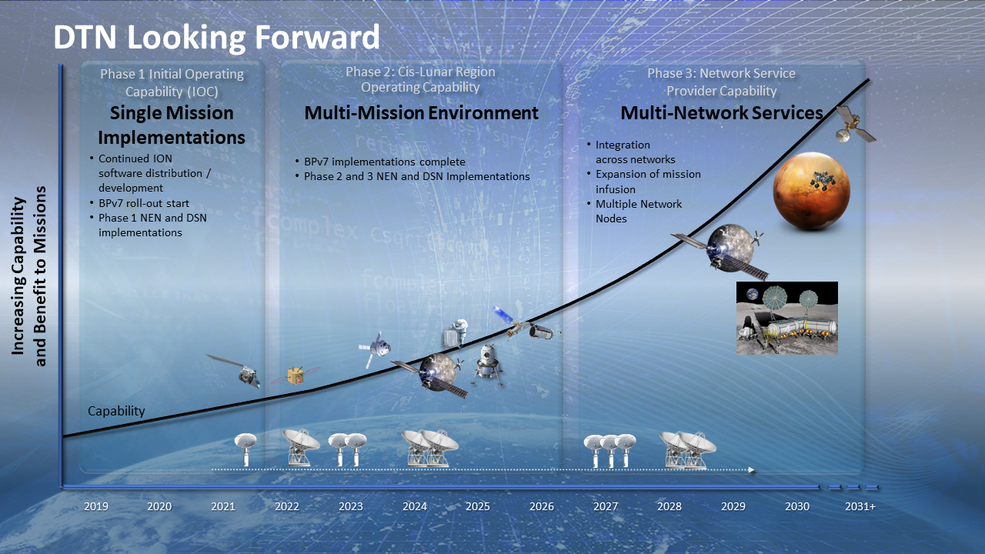What is DTN?
Delay/Disruption Tolerant Networking (DTN) is a suite of standard protocols that use information within the data stream (headers attached to data units) to accomplish end-to-end data delivery through network nodes. DTN enables data delivery in situations that involve
- Disconnections (e.g., end-to-end link unavailability)
- Delays (e.g., Deep Space missions)
- Data rate mismatches (e.g., high data rate Science downlinks but lower rate terrestrial connections)
A DTN architecture is a store-and-forward communications architecture in which source nodes send DTN bundles through a network to destination nodes.
Why has DTN been developed?
The goal of DTN is to enable networked-based communications—analogous to those provided by the terrestrial Internet—in any mission scenario, including scenarios where the terrestrial Internet Protocol (IP) suite cannot be used. DTN enables data delivery in situations that involve
- Disconnections (e.g., end-to-end link unavailability)
- Delays (e.g., Deep Space missions)
- Data rate mismatches (e.g., high data rate Science downlinks but lower rate terrestrial connections)
DTN provides a general-purpose network-/transport-layer service that is logically similar to what TCP/IP provides for the terrestrial Internet, but suitable for use in the space environment. In addition to the basic store-and-forward internetworking service, DTN also provides: efficient reliability; security; in-order delivery; duplicate suppression; class of service (prioritization); remote management; a ‘DVR-like’ streaming service, rate buffering, and data accounting, all over possibly asymmetric and time-disjoint paths. Multiple applications including file transfer, messaging (e.g. for mission operations), and streaming audio/video can all be implemented on top of DTN and leverage its services to reduce risk, cost, and complexity.
What implementations currently exist?
There are a number of software implementations of DTN. NASA’s Interplanetary Overlay Network (ION) and Core Flight System (cFS) are readily available.
What are the current DTN standards?
- CCSDS Bundle Protocol Specification – Recommended Standard that defines a CCSDS Bundle Protocol based on the Bundle Protocol of RFC 5050, with necessary extensions to support the Delay/Disruption Tolerant Networking (DTN) of space applications
- IETF DTN page*– Provides the latest draft specifications developed by the Internet Engineering Task Force (IETF) DTN Working Group
Who is currently using DTN?
Several operational payloads and demonstrations on the International Space Station currently use DTN as shown in the table below
Payloads Using DTN (International Space Station DTN Gateway)
- LSG Laptop (ER4) (JEM)
- MVP-02 (ER4) (JEM)
- Plant Habitat (ER5) (JEM)
- Spectrum (ER6) (USL ER1)
- Tangoab-2 (ER6) (USL ER1)
- HERMES (ER6) (USL ER1)
- Cold Atom Lab (ER7) (USL ER2)
- MVP (ER8) (USL ER2)
- S.A.M. (ER8) (USL ER2)
- NanoRack PF 1 and 2
- NanoRack PF2 (ER 10-8) (JEM)
- HRF-1 (COL)
- HRF-2 (COL)
- HRF Laptop 3 (COL)
- ECOSTRESS PL VM
- DMC VM
- TReK Flight Demo Laptop
International Space Station DTN Tech Demos (Arcturus)
Arcturus is a network-based communications system designed to transmit data between devices running on-board the International Space Station and displays running in the Mission Control Center at Johnson Space Center in Houston. Arcturus leverages the DTN gateway capability of the Station Support Computer (SSC) System to provide a level of store-and‐forward communications, allowing a device to send data to the system during loss‐of-signal (LOS) periods when network communications to ground systems is not available.
- EMU Data Recorder (EDaR)
- Thermal Amine System (TAS)
- High Definition EVA Camera Assembly (HECA); Software deployed. No hardware.
- Brine Processor Assembly (BPA)
- 4 Bed CO2 Processor (4BCO2)
- Mini CO2 Processor (MICO2)
- Urine Transfer System (UTS)
- Toilet Data Recorder (TDR)
- H2 Sensor Technology (H2ST)
- Artemis HERA on Space Station (AHoSS)
- Carbon Dioxide Adlink sensor (cdaXX)
Who is planning to use DTN?
- Mobile Space Lab
- Astrobee 1
- Astrobee 2
- Tangolab PAUL
- Spectrum
- BioFabrication Facility
- MVP-02
- BEC Atom Lab
- MSG
- Spaceborne 2
Other Future DTN Users
- Lunar IceCube
- Lunar Flashlight
- Plankton, Aerosol, Cloud, ocean Ecosystem (PACE)
- KPLO (NASA partnership with Korea Aerospace Research Institute)
- Gateway (Artemis)
Are there any planned updates to DTN protocols?
Several new and updated protocols and specifications were released in January 2022. They provide increased capability and security, and they build upon the experience and lessons learned from previous experimental versions.
- Bundle Protocol Version 7
- Bundle Protocol Security (BPSec)
- Default Security Contexts for BPSec
- Delay-Tolerant Networking TCP Convergence-Layer Protocol Version
Additional details can be found on the Internet Engineering Task Force (IETF) DTN site linked here.
What are NASA’s plans for infusing DTN across its communication networks?
The SCaN program is using a three-phased approach to deploy DTN-enabled operational communications support across the SCaN Network. Its Initial Operating Capability (IOC) is expected in 2021, to support the upcoming DTN users PACE (via the NSN) and KPLO (via the DSN).




























